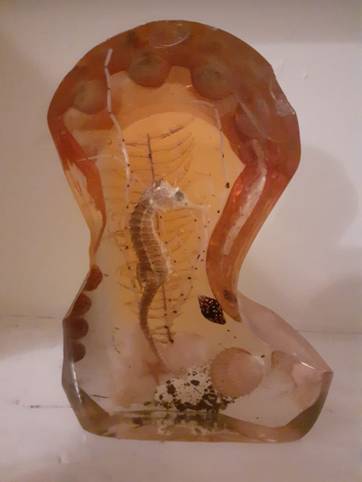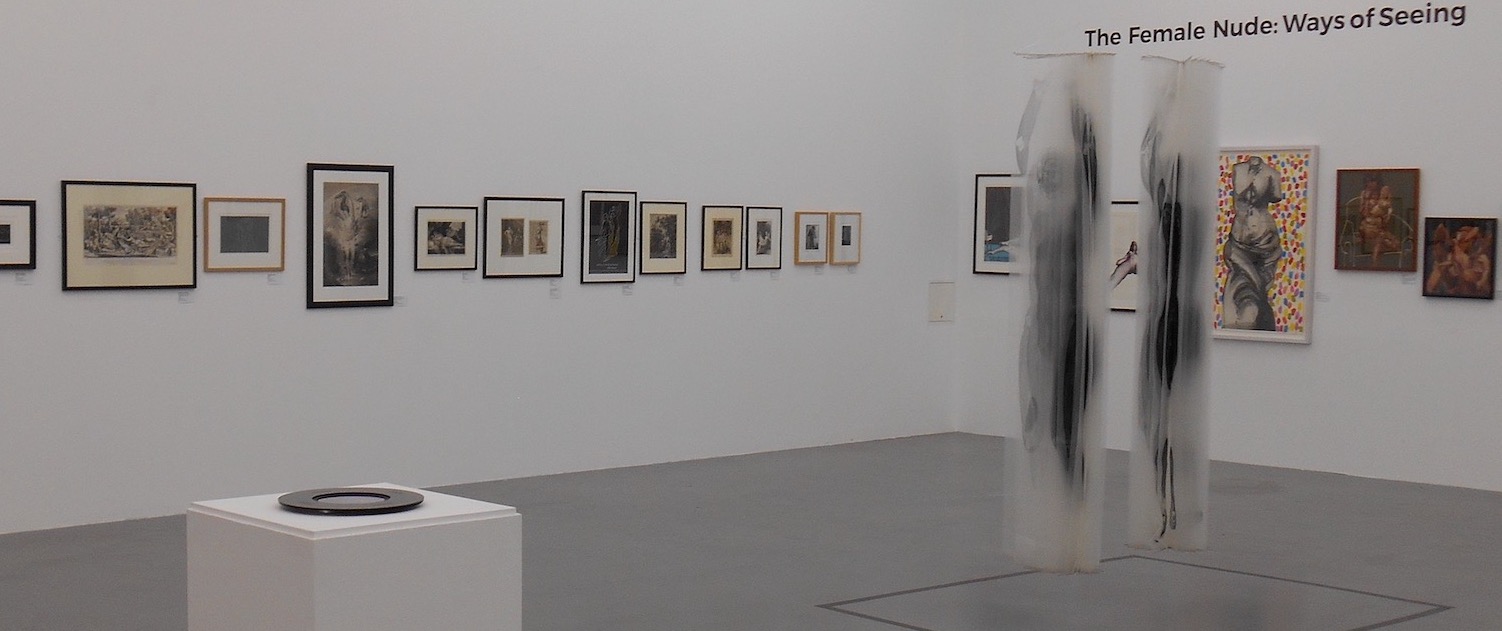Objet Trouvé
by George Stocker

The orange hue of the boot shaped embalming envelops the ocean scene, at its centre is the skeletal remains of a Sea horse, whose skull appears a grey/white colour, the rest of its body a sandy brown. Three white spiny sea plants protrude from the Seahorse, these, coupled with a white (dead) chunk of coral add to the scenes morbid skeletal appearance, and its motifs of death and decay. The scene is physically and metaphorically soiled by the specs of dark brown dirt, at the foot of the embalming. Creating a jarring juxtaposition of colour against the whites and oranges. Additionally two sea shells are apathetically scattered below the Sea Horse, reminding the viewer that the scene is a recreation of an ocean scene, rather than a display of melancholia and death.
Preservation of time, and the inevitability of death, are very present in this image, and create a sense of the “eternal return”. As Salvador Dalí wrote on the decayed form of his Putrefied Donkey (1928), “in this case no meaning is attachable to the distinct forms of the image apart from the notion of time”; therefore the skeletal remains of the Seahorse and the dead coral rock, are constant reminders of time, and its inevitable consequence (death). The embalming of this scene, suspends a moment in time allowing it to reoccur every time the object is viewed. Therefore becoming a representation of Nietzsche’s concept of the “eternal return”, in which “the same cycle covering a certain time span, infinitely repeats itself over and over” (Oger, 1997: 1), all events have been previously experienced and cyclically repeat themselves, without change. The evident reminder of death in this image, represents the unchangeable cycle, and the ability to revisit this moment (from the embalming), represents the cyclical repeat and return to already experienced events of the “eternal return”.
A subconscious fetishist desire projects itself through the objects boot like shape, and the finger marks within. This object creates a chance encounter, between the hand and the boot, which usually contrast each other. This chance encounter relates to the work Les Chants de Maldoror (1868-69) by poet Comte de Lautréamont, who uses the “beautiful” “chance encounter of a sewing machine and an umbrella on an operating table.” To describe a sixteen year old boy (Barratt, 1959: 301). The chance meeting of opposites, within this completely unrelated sphere of ocean space, creates a perverse marriage, that births the objects unsettling nature. Only emphasised by the fetishising of the foot, and the sensual connections of placing the hand within this. Therefore, by applying the surrealist ideas of fetish and desire, it can be inferred that the skeleton of a Seahorse, represents Freud’s idea of the fetish object replacing the penis, in a form of castration (Freud, and these ideas influenced Surrealism greatly) (Apter, 1991: 1-2). The male Seahorse with its ability to give birth, takes on a feminised attribute, as does the male human in castration, as society see the testicles as a symbol of masculinity. Additionally the Seahorse being evidently dead emphasises the male fear around fetish/castration, and the loss/death of masculinity that it brings, the fetish and uncontrollable sexual desire being seen as giving power to the female (demasculinising the male), and castration the physical representation of this.
Personally this objects meaning has evolved, through similar revelatory associations, that Breton describes when he writes “It was when I got home and placed the spoon on a piece of furniture that I suddenly saw it charged with all the associative and interpretative qualities which had remained inactive while I was holding it” (Breton, 1937: 33). In this passage of Mad Love (1937), Breton describes the trip to a flea market, accompanied by Alberto Giacometti, in which both acquire objects that provide them artistic and internal revelation. Breton believes “The sympathy existing between two or several beings seems to lead them toward solutions they would have never found on their own” (Breton, 1937: 34). This found object (I’ve possessed for multiple years) I eventually came to relate to my mum (who has an affection for the Seahorse). Similar to Breton, it took a change of perspective (of life, rather than of the object) to develop these associations. The objects melancholic undertones, and constant reminders of time, and decay, correlate to a personal transition away from the childlike mind which attaches itself to the mother, viewing her as eternal. To the minds realisation of her mortality (in adulthood). This understanding can only develop through the sympathy between me and my mother. Understanding the personal subconscious connotations of this object, creates an internal revelation, only now explaining multiple anxieties of the pubescent transition.
Bibliography:
APTER, E. (1991). “Fetishism in Theory: Marx, Freud, Baudrillard”. In Feminizing the Fetish: Psychoanalysis and Narrative Obsession in Turn-of-the Century France (pp. 1-14). ITHACA; LONDON: Cornell University Press. Available at: http://www.jstor.org/stable/10.7591/j.ctt207g6z5.4 (date viewed 20/02/2021)
Baldacci, Paolo (1997). “De Chirico: the metaphysical period, 1888-1919”. Boston, New York, Toronto, and London: Bulfinch press.
Barrett, C. (1959). “The Meaning Doesn’t Matter?: Some Reflections on Modern Abstract Painting”. Studies: An Irish Quarterly Review, 48(191), 291-304. Available at:http://www.jstor.org/stable/30103619(Date viewed 22/02/2021)
Breton, André (1937). “Mad Love”, pp.25-38, Lincoln, London
Dali, Salvador (1928) “The Stinking Ass”. Found in Mary Ann Caws (ed.), “Surrealist Painters and Poets: An Anthology”, 2001 pp.179-184
Oger, E. (1997). “The eternal return as crucial test”. Journal of Nietzsche Studies, (14), 1-18. Available at: http://www.jstor.org/stable/20717674 (date viewed 09/02/2021)
